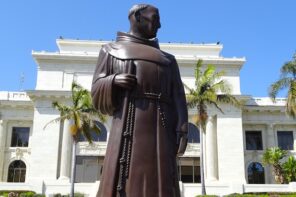After Ireland made history in May 2015 by becoming the first country to legalize same-sex marriage by popular referendum, the Vatican secretary of state did not make history by calling the event a “defeat for humanity.”
Speaking to the press in the midst of a conference on economic and social issues, Cardinal Pietro Parolin said he was “deeply saddened” by the results of the referendum. “The church must take account of this reality, but in the sense that it must strengthen its commitment to evangelization. I think that you cannot just talk of a defeat for Christian principles, but of a defeat for humanity.” Pope Francis, once again confounding some liberals’ fondest hopes for his papacy, said nothing to distance himself from the second most prominent representative of the Church.
Although not covered by most Anglophone media, Cardinal Parolin’s remarks at the close of the conference were also revealing. Noting that “the Popes have insisted on the centrality of the person,” Parolin asserted that social practices “must always be anchored in the dignity of the human person, and the common good.”
Parolin is correct that for some time, popes have spoken of the dignity of the human person, a phrase that may sound familiar from the U.N. Charter and Declaration of Human Rights. But as his statements lay bare, this Catholic usage is strikingly different from the usage in the contemporary discourse of human rights. What to make of the human rights legacy of Christianity, and conservative Catholic thought in particular, is the subject of a vigorous debate among historians at The Immanent Frame.
One leader in this field, Samuel Moyn, has argued in his recent work that personal dignity entered post-war legal and political thought thanks largely to a European Catholic intellectual movement known as personalism. Here is Moyn’s summary of the movement in “Personalism, Community, and the Origins of Human Rights,” a chapter from his forthcoming book, Christian Human Rights:
Personalism—linked quickly to spiritualism and humanism, and not infrequently to European identity—meant a repudiation of the rival materialisms of liberalism and communism. In the first place, then, personalism was different than individualism, for it championed a figure who was supposed to overcome the destitute atomism of the politics and economics of the nineteenth century. If, however, the person provided a connection to community that individualism ruled out, it also provided the key source of value omitted in, and the political bulwark against, communism.
In advancing a spiritual communitarianism over secular communism and secular liberalism, personalists such as Jacques Maritain could speak of the “human rights” grounded in “the dignity of the human person” even while renouncing the rights traditions of the Enlightenment and French Revolution.
Moyn makes the case that this notion of rights grounded in dignity was adopted by Pope Pius XI and Pope Pius XII and through them, by the world. In a 2014 article, “The Secret History of Constitutional Dignity,” he claims it is “self-evident that the prominence of this notion in wartime, including its connection to rights, was due to the Pope more than all others.” Even the U.N. Charter, he says, registers papal usage, “for there is no other obvious source.”
Moyn’s motivation is not that of the Christian culture warrior who would beamingly trace back to Jerusalem everything now esteemed in our culture. Rather, in exposing the conservative lineage of human rights, he seems to want to break liberals’ enthrallment to the ideology of human rights, an ideology he considers insufficiently radical—i.e., welfarist and redistributionist—to address global socioeconomic inequality.
From what I can gather, European historians differ in the amount they are willing to credit the personalists for papal talk of dignity and rights. In his critical commentary on Moyn’s work, for instance, James Chappel observes that in the 1930s, “the language of ‘rights’ and ‘the human person’ was quite widespread throughout European, especially German-speaking, Catholicism, which renders the Pope’s usage of the language less mysterious.”
A more fundamental problem with Moyn’s analysis is that he equivocates between two ways of thinking about the language of dignity and rights, or any public discourse for that matter. We can think of “dignity,” “rights,” and “the human person” as rhetorical tropes or as a set of moral-legal concepts denoted by these tropes. The same tropes can refer to importantly different concepts. One can write and speak about “the dignity of the person,” for instance, while rejecting—or remaining totally unaware of—the personalists’ particular anti-liberal and anti-secular understanding of this concept.
Moyn acknowledges in passing that the rhetoric of rights and the person may have prevailed precisely because of the “indeterminacy” of its conceptual content. Yet he never reckons with the implications for his argument as a whole. Instead, he quietly exchanges concepts for tropes or tropes for concepts depending on which best suits his argumentative purposes at the moment. When arguing that mid-century Catholics weren’t merely carrying on the 18th century revolutionary tradition, he rests his case on their novel, anti-individualist concept of rights: the moment was a “novel and fateful departure” precisely because the concept was different. When arguing for Catholic influence on the broader political culture, however, Moyn shifts his case to the trope: here it is not important that the United Nations’ concept of dignity and rights was different from the Vatican’s concept so long as their rhetoric was the same.
The conceptual difference is far from trivial. It may be intriguing to know that various notions of human rights were circulating at mid-century, including some expressly anti-liberal notions. But we can still ask which of those notions were widely adopted in international politics and law and which were not. Consider the inclusion of personal dignity in the U.N. Charter and Declaration of Human Rights. The preamble to the Charter begins
WE THE PEOPLES OF THE UNITED NATIONS determined
to save succeeding generations from the scourge of war, which twice in our lifetime has brought untold sorrow to mankind, and
to regain faith in fundamental human rights, in the dignity and worth of the human person, in the equal rights of men and women and of nations large and small . . . .
The preamble was drafted by the head of the South African delegation, Marshal Jan Christiaan Smuts. It was an American delegate to the San Francisco conference, Barnard College dean Virginia Gildersleeve, who modified Smuts’ text and thereby “singlehandedly [introduced] the allusion to “the dignity and worth of the human person,” Moyn writes.
Actually, as Moyn himself blogged after visiting the Gildersleeve papers at Columbia, the New Zealand delegation may have been the first to suggest the addition of “the dignity of man.” Under the leadership of the Labor Prime Minister Peter Fraser, New Zealand had made common cause with a number of smaller countries and civil society organizations in pressing for recognition of human rights in the Charter. Oddly, Moyn credits the political theorist Charles Beitz with the “remarkable discovery” of Gildersleeve’s contribution, although Gildersleeve described the events in a memoir published in 1954 (the fact even appears in an otherwise meager Wikipedia entry, which cites a 2001 alumni magazine article).
The records show that Gildersleeve’s edit replaced Smuts’ “sanctity and ultimate value of human personality” with “dignity and value of the individual.” Subsequently, “value” was changed to “worth” and “human being” to “human person,” a near-return to Smuts’ “personality.” As Moyn and Beitz report, these edits took place without objection or hermeneutical incident. This is telling. If the tropes had been heard as referring to distinctly Catholic concepts, their inclusion and their exchange with other terms likely would have met with protest.
This was, after all, a deliberately multiconfessional and non-religious environment. A few years later, during the negotiation of the Declaration of Human Rights, delegates considered and rejected an amendment stating that “all human beings are created in the image and likeness of God.” Even Maritain, who served on a committee of philosophical advisers to the project, had concluded that practical consensus on human rights should proceed without consensus on moral foundations.
Furthermore, Smuts—who had studied psychology while at Cambridge—had his own idiosyncratic notion of “Personality” rooted in a quasi-evolutionary metaphysics of “holism.” In a 1926 book entitled Holism and Evolution, Smuts sought to
trace the concept of Personality to its real relationships in the order of the universe, to show it as not merely a juristic or religious or philosophical concept, but as a real factor which forms the culminating phase in the synthetic creative Evolution of the universe. . . . Here Personality becomes the last term in the holistic series, a reality in line with other realities which mark the creative forward march of Holism.
A new discipline of “Personology” would integrate “all of the human sciences” to explore the “uniquely individual” character of personality. Whatever one makes of this stuff, Catholic personalism it is not.
And what of the rhetoric of dignity? Notwithstanding Moyn’s claim that there is “no other obvious source” except for the Pope, I was able to think of one (as a non-historian, I am not qualified to go beyond the obvious): the President of the United States. Franklin D. Roosevelt’s address to Congress on January 6, 1941—the celebrated “Four Freedoms” speech—called for a foreign policy founded on “a decent respect for the rights and the dignity” of all and defined freedom as “the supremacy of human rights everywhere.” Once again, it’s a similar trope, but it’s not obviously a conservative Catholic concept.
All of this leaves me more persuaded by Chappel, who sees Moyn’s narrative of mid-century “Christian human rights” as a history of “appropriation of human rights discourse” by the Church, “a Church that was attempting to cozy up to Atlantic powers at a very frightening time, using a well-established Catholic language that seemed to rhyme with established liberal commitments.”
Cardinal Parolin’s language may rhyme with the language of human rights. Nevertheless, the concept of human rights is, as it was in 1945, unmoored from any religious or philosophical outlook. As for its individualism, there are two important exceptions in the foundational texts: “peoples” right to self-determination, provided in the International Covenant on Civil and Political Rights (ICCPR), the enforceable treaty adopted in 1966, and the family’s right to protection as “the natural and fundamental group unit of society,” contained in the Declaration and the ICCPR.
This deeply patriarchal and adultist protection of the natural family more than rhymes with the rhetoric of contemporary religious right activism in the global public square. Can I at least blame that on Catholics?





